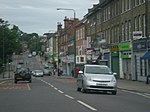Huguenot Burial Site
1687 establishments in EnglandCemeteries in LondonHistory of the London Borough of WandsworthHuguenot cemeteriesHuguenot history in the United Kingdom

The Huguenot Burial Site (also known as Mount Nod Cemetery) is a former burial ground for Huguenots in Wandsworth, London. It was in use from 1687 to 1854. The burial site is located between East Hill and Huguenot Place in the London Borough of Wandsworth. It is located next to St Mary Magdalen Roman Catholic Church.
Excerpt from the Wikipedia article Huguenot Burial Site (License: CC BY-SA 3.0, Authors, Images).Huguenot Burial Site
Huguenot Place, London Earlsfield (London Borough of Wandsworth)
Geographical coordinates (GPS) Address External links Nearby Places Show on map
Geographical coordinates (GPS)
| Latitude | Longitude |
|---|---|
| N 51.458148 ° | E -0.18343 ° |
Address
Huguenot Burial Ground (Mount Nod)
Huguenot Place
SW18 2EN London, Earlsfield (London Borough of Wandsworth)
England, United Kingdom
Open on Google Maps








